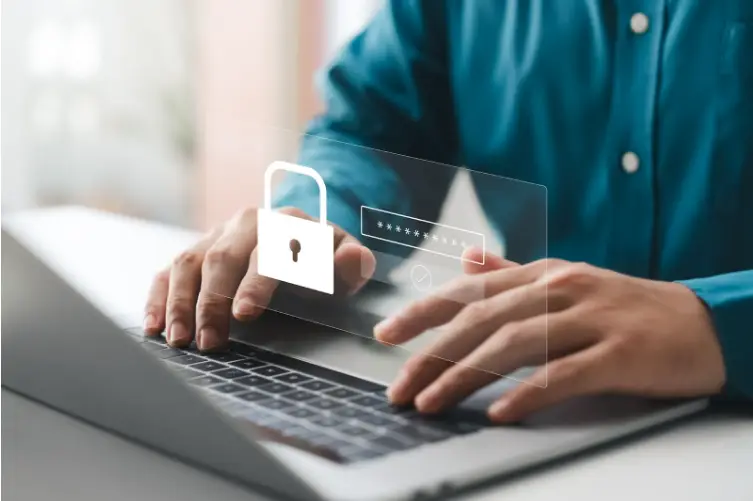Your digital footprint is the trail of data you leave behind (digital exhaust) every time you browse, shop, post, or sign up online.
As we spend a lot of time on the internet, our digital footprint is bigger and more revealing than we think. It includes everything from your social media profiles to outdated accounts, public records, and even data broker listings you’ve never heard of.
So, how to remove your digital footprint?
While you can’t erase every trace of yourself from the internet, you can significantly reduce your online exposure by deleting old accounts, opting out of data broker sites, and removing personal information from search engines and directories.
Why does this matter? Unmanaged digital footprints can lead to identity theft, doxxing, spam, or reputational harm. Taking control of your online presence is no longer optional—it’s a must for protecting your privacy and avoiding cyberattacks from threat actors.
Key Takeaways
- You can’t fully erase your digital footprint, but you can significantly reduce your online exposure and control what others can find.
- Start by checking your current digital footprint — search your name, audit your social media, and scan for leaked credentials.
- Delete or deactivate old accounts that you no longer use to close off unnecessary data leaks.
- To remove sensitive personal information from public listings, opt out of people search sites and data brokers like Whitepages and Spokeo.
- Use Google’s removal tools to hide personal data from search results, and contact site owners to fully delete content.
- Tighten your privacy settings across social media, browsers, and mobile apps to limit passive data collection.
- Use tools like VPNs, password managers, and anti-tracking extensions to protect your data more effectively.
- Make privacy a habit by reviewing your digital presence regularly and practicing strong digital hygiene.
Can You Really Delete Your Digital Footprint?
Unfortunately, it’s not possible to fully remove personal information from the Internet, because once something is shared online, it often spreads beyond your control. Emails are forwarded, social media posts are archived, and personal details get scraped by third-party sites or stored in data warehouses.
The key distinction is this: deletion implies total removal, while reduction means minimizing what’s publicly visible and easily accessible. Think of it like cleaning up after a party — you may not erase every footprint, but you can pick up the clutter and lock the doors.
What Can Be Achieved?
The goal isn’t perfection, but applying digital footprint safety tips to limit exposure, control visibility, and reduce the risks of identity theft, surveillance, targeted scams, and reputational harm.
When you remove your personal data from high-risk sources (like people search sites and outdated accounts), you can get more control over your online presence and make it much harder for bad actors to find and misuse your information.
1. Check Your Digital Footprint First
Before you can start reducing your digital footprint, you need to know what’s out there. These steps will help you identify where your personal data is exposed:
- Google yourself: Start with a simple search for your full name. Add keywords like your city, employer, or username to surface more specific results.
- Use reverse image search: Tools like Google Images or TinEye can uncover where your profile pictures or other personal images appear online.
- Run a dark web scan: Free tools from services like Have I Been Pwned or your antivirus provider can check if your emails, passwords, or personal info have been exposed in data breaches. There are also more professional dark web monitoring tools for businesses that need to be particularly cautious about their executives’ and other employees’ data.
- Audit your social media: Review what’s public on your accounts, paying attention to old posts, tagged photos, bios, and privacy settings, which are common leaks.
- Check browser and device logs: Look for saved login data, cookies, browsing history, and device tracking that could reveal more than you realize.
2. Delete or Deactivate Unused Accounts
Forgotten accounts, which are no longer actively managed, are especially vulnerable to cyberattacks, as users are less likely to update credentials or notice unauthorized access to them.
Start by using a password manager (like LastPass or Bitwarden) or your browser’s saved credentials to identify accounts you haven’t used in a while. You can also search your email for terms like “welcome,” “verify your email,” or “account created” to find sign-up confirmations.
General Steps to Delete Old Accounts
- Visit the website and log in.
- Go to account settings or privacy options.
- Look for a “Delete” or “Close Account” option.
- If none exists, contact customer support and request removal.
- Confirm deletion via email and save a copy for your records.
If deletion isn’t possible, at least deactivate or anonymize the account by removing personal info and changing the email address.

3. Opt Out of People Search Sites and Data Brokers
Data brokers like Whitepages or Spokeo collect and publish your personal information (including your home address, phone number, age, and relatives) without your consent.
These sites scrape data from public records, social media, and marketing databases, then sell it to advertisers, recruiters, or even bad actors.
To protect your privacy, you’ll need to manually opt out of each site:
How to Remove Info from Whitepages
Whitepages is one of the most widely used people search sites, and one of the most aggressive in reposting data, so it’s worth knowing how to deal with it in particular. To remove your listing:
- Go to the Whitepages opt-out page.
- Search for your name and location to find your listing.
- Click “View Details,” then “Remove Me.”
- Verify your identity via phone call or text message.
- Submit the removal request and wait for confirmation.
The process usually takes a few days to complete. Phone verification is mandatory, and they’ll only remove the specific listing you request, not every instance of your name.
Keep in mind that your information can be re-listed later, especially if it’s pulled again from public records. Regular checks or using a data broker removal service like VanishID can help keep your data off the site long-term.
4. Remove Your Info from Search Engines and Google
Even after deleting data from websites, your personal information may still show up in Google search results.
To get rid of it, use Google’s Personal Content Removal Tool, a free service that lets you request the removal of sensitive data like your home address, phone number, or leaked credentials.
- Go to the Google Removal Tool.
- Choose the type of content you want removed (e.g., personal info, doxxing, outdated pages).
- Submit the URL(s) of the offending search results.
- Monitor the request via email updates.
Important: This process removes the result from Google Search, not the source website. The data still exists unless it’s removed at the original source.
For full deletion, you’ll need to contact the webmaster of the site hosting your information. Look for a “Contact” or “Privacy” link on the site, or use a WHOIS lookup to find the owner’s info.
5. Tighten Privacy Settings Everywhere
One of the easiest ways to reduce your digital footprint is to lock down your privacy settings on social media, mobile apps, and browsers.
- Social media: Set your profiles to private, limit who can see your posts, and disable options like tagging, facial recognition, and public search visibility. Review your old posts and consider deleting any that are overly personal or sensitive.
- Mobile apps: Many apps collect far more data than they need. Go into your phone’s settings and revoke access to your camera, contacts, microphone, and location for apps that don’t truly require them.
- Browsers: Block third-party cookies, turn off ad tracking, and consider using privacy-focused browsers like Brave, Firefox, or DuckDuckGo. Installing extensions like uBlock Origin or Privacy Badger can also help reduce passive tracking.

6. Use Privacy Tools to Reduce Exposure
Even if you can’t erase your entire digital footprint, you can make it much harder for others to track you. The right privacy tools help reduce your exposure in everyday browsing and account usage.
- VPNs (Virtual Private Networks): A VPN encrypts your internet traffic and hides your real IP address, making it more difficult for websites, advertisers, and even your ISP to track your location or activity.
- Password managers: Tools like 1Password or Bitwarden generate strong, unique passwords and store them securely. Many also help you identify old or reused accounts that could be deleted or updated.
- Anti-tracking browser extensions: Add-ons like Privacy Badger, uBlock Origin, or Ghostery block trackers, ads, and scripts that follow your behavior across the web.
- Temporary email services: Use disposable email addresses (like from TempMail or SimpleLogin) when signing up for newsletters or one-time services to avoid spam and limit long-term data collection.
7. Practice Digital Hygiene Going Forward
Removing personal information from the Internet needs to be an ongoing process, as you can’t predict how your digital footprint will spread over time.
For this reason, following digital hygiene practices regularly is essential for reducing the constantly evolving cybersecurity risks.
Build Privacy Into Your Everyday Habits
Start by avoiding oversharing. Think twice before posting your location, birthday, job title, or family details on social media, as even innocent posts can be pieced together by data brokers, scammers, or identity thieves.
Make it a habit to periodically Google yourself to see what’s publicly visible. Set up Google Alerts for your name and email so you’re notified when new data surfaces. Regular checks help you catch and remove new exposures early.
Strengthen Your Accounts and Communication
Update your passwords regularly and use a password manager to avoid reusing them. Always enable multi-factor authentication (MFA) where available — it helps you keep your online accounts more secure, even if your login is compromised.
Finally, consider using alias emails for different services. Avoid linking everything to one Google or Facebook login, as that can create a single point of failure and allow companies to track you across platforms.

How to Erase Digital Footprint – Final Thoughts
Cleaning up your digital footprint isn’t something you do once and forget. It requires regular attention, just like managing your finances or health. As the internet evolves and data collection grows more aggressive, staying private means staying proactive.
Make a habit of checking your digital presence regularly. Review your search results, tighten your privacy settings, delete old accounts, and stay informed about where your information may be exposed. Think of privacy as a lifestyle — one built on awareness, intention, and smart tools.
To help you stay on track, we’ve created a checklist you can use to walk through each step at your own pace:
- Check your digital footprint first
- Delete or deactivate unused accounts
- Opt out of people search sites and data brokers
- Remove your info from search engines and Google
- Tighten privacy settings everywhere
- Use privacy tools to reduce exposure
- Practice digital hygiene going forward
And if all this sounds like a full-time job, you’re not wrong. It can be very time-consuming, especially when you need to provide digital protection for your executives.
That’s where VanishID comes in. Our professional services automate the most tedious parts of digital footprint cleanup, from data broker removals to ongoing monitoring and takedown requests. Let us do the hard work so you can focus on what matters without leaving your data behind.
Start protecting your executives today with VanishID!
Andrew Clark
Head of Growth Marketing, VanishID
Andrew is a digital marketing strategist specializing in demand generation and customer acquisition for B2B SaaS and cybersecurity companies. He focuses on understanding customer pain points in executive protection and digital footprint management. Prior to VanishID, Andrew led digital marketing at various startups and enterprises, building full-funnel campaigns and launching websites across cybersecurity, cloud simulation, and healthcare sectors. He holds a BA in Communication and Minor in Psychology from the University of Minnesota Duluth.
All PostsAbout VanishID (Formerly Picnic)
VanishID is an agentic AI-powered company that neutralizes public data exposure for organizations and their employees. By continuously monitoring and reducing exposure to open-source intelligence (OSINT), VanishID extends security beyond the corporate perimeter, safeguarding business continuity and organizational integrity.


